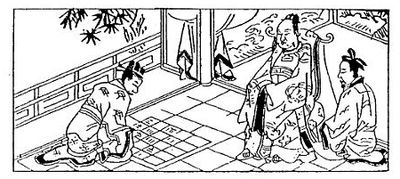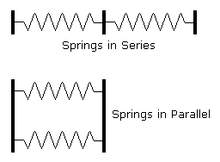(Created page with "== '''Problem''' == Consider two springs with different spring constants <math> k_1 </math> and <math> k_2 </math>. '''Part 1:''' Determine the equivalent spring constant wh...") Tag: Visual edit |
m (Stevenzheng moved page Two Springs in Series and Parallel to Springs in Series and Parallel) |
||
| (5 intermediate revisions by the same user not shown) | |||
| Line 3: | Line 3: | ||
'''Part 1:''' Determine the equivalent spring constant when the two springs are connected in series. |
'''Part 1:''' Determine the equivalent spring constant when the two springs are connected in series. |
||
| + | |||
'''Part 2:''' Determine the equivalent spring constant when the two springs are connected in parallel. |
'''Part 2:''' Determine the equivalent spring constant when the two springs are connected in parallel. |
||
[[File:Springs.gif|centre|thumb|220x220px]] |
[[File:Springs.gif|centre|thumb|220x220px]] |
||
== '''Solution''' == |
== '''Solution''' == |
||
| + | '''Part 1: Springs connected in series (same forces, different length)''' |
||
| + | |||
| + | When two springs are connected in series, the result is essentially a longer and flimsier spring. When a force is applied to the combined spring, the same force is applied to each individual spring. Since the springs have different spring constants, the displacements are different. Thus we get three equations: |
||
| + | # <math> {F}_{app} = {k}_{eq} (x_1 + x_2) </math> |
||
| + | # <math> {F}_{app} = k_1 x_1 </math> |
||
| + | # <math> {F}_{app} = k_2 x_2 </math> |
||
| + | First equate equations 2 and 3 and isolate for <math> x_2 </math> |
||
| + | :<math> k_1 x_1 = k_2 x_2 </math> |
||
| + | :<math> x_2 = \frac{k_1 x_1}{k_2} </math>. |
||
| + | Substitute <math> x_2 </math> into equation 1. |
||
| + | :<math> {F}_{app} = {k}_{eq} \left( x_1 + \frac{k_1 x_1}{k_2}\right) </math> |
||
| + | :<math> {F}_{app} = {k}_{eq} \left( 1 + \frac{k_1}{k_2}\right)x_1 </math> |
||
| + | To solve for the equivalent spring constant, set the above equation with equation 2. The strategy is to divide away <math> x_1 </math>. |
||
| + | :<math> {k}_{eq} \left( 1 + \frac{k_1}{k_2}\right)x_1 = k_1 x_1 </math> |
||
| + | :<math> {k}_{eq} = \frac{k_1 k_2}{k_1 + k_2} </math> |
||
| + | |||
| + | In general, given <math> n </math> springs added in series |
||
| + | :<math> \frac{1}{{k}_{eq}} = \frac{1}{k_1} + \frac{1}{k_2} + \frac{1}{k_3} + ... + \frac{1}{k_n} </math>. |
||
| + | |||
| + | '''Part 2: Springs connected in parallel (same length, different forces)''' |
||
| + | |||
| + | When two springs are connected in parallel, the result is essentially two springs working together. When a force is applied to the combined spring, the force applied on each individual spring is different. Thus we get three equations: |
||
| + | # <math> {F}_{1} = k_1 x </math> |
||
| + | # <math> {F}_{2} = k_2 x </math> |
||
| + | # <math> {F}_{app} = {k}_{eq} x = F_1 + F_2 </math> |
||
| + | Thus |
||
| + | :<math> {k}_{eq} x = k_1 x + k_2 x </math> |
||
| + | :<math> {k}_{eq} x = (k_1 + k_2) x </math>. |
||
| + | Therefore, |
||
| + | :<math> {k}_{eq} = k_1 + k_2 </math>. |
||
| + | |||
| + | In general, given <math> n </math> springs added in parallel |
||
| + | :<math> {k}_{eq} = {k}_{1} + {k}_{2} + {k}_{3} +... + {k}_{n}</math>. |
||
| + | [[Category:Physics]] |
||
| + | [[Category:Mechanics]] |
||
Latest revision as of 17:35, 2 May 2018
Problem
Consider two springs with different spring constants and .
Part 1: Determine the equivalent spring constant when the two springs are connected in series.
Part 2: Determine the equivalent spring constant when the two springs are connected in parallel.
Solution
Part 1: Springs connected in series (same forces, different length)
When two springs are connected in series, the result is essentially a longer and flimsier spring. When a force is applied to the combined spring, the same force is applied to each individual spring. Since the springs have different spring constants, the displacements are different. Thus we get three equations:
First equate equations 2 and 3 and isolate for
- .
Substitute into equation 1.
To solve for the equivalent spring constant, set the above equation with equation 2. The strategy is to divide away .
In general, given springs added in series
- .
Part 2: Springs connected in parallel (same length, different forces)
When two springs are connected in parallel, the result is essentially two springs working together. When a force is applied to the combined spring, the force applied on each individual spring is different. Thus we get three equations:
Thus
- .
Therefore,
- .
In general, given springs added in parallel
- .























